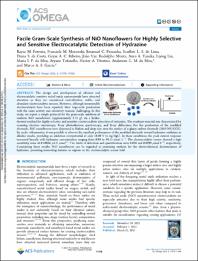Mostrar el registro sencillo del ítem
Facile Gram-Scale Synthesis of NiO Nanoflowers for Highly Selective and Sensitive Electrocatalytic Detection of Hydrazine
| dc.contributor.author | Ferreira, Rayse M. | |
| dc.contributor.author | Ferreira, Rayse M. | |
| dc.contributor.author | Morawski, Franciele M. | |
| dc.contributor.author | Pessanha, Emanuel C. | |
| dc.contributor.author | de Lima, Scarllett L. S. | |
| dc.contributor.author | Costa, Diana S. da | |
| dc.contributor.author | Ribeiro, Geyse A. C. | |
| dc.contributor.author | Vaz, João | |
| dc.contributor.author | Mouta, Rodolpho | |
| dc.contributor.author | Tanaka, Auro A. | |
| dc.contributor.author | Liu, Liying | |
| dc.contributor.author | da Silva, Maria I. P. | |
| dc.contributor.author | Tofanello, Aryane | |
| dc.contributor.author | Vitorino, Hector A. | |
| dc.contributor.author | da Silva, Anderson G. M. | |
| dc.contributor.author | Garcia, Marco A. S. | |
| dc.date.accessioned | 2023-09-22T17:12:47Z | |
| dc.date.available | 2023-09-22T17:12:47Z | |
| dc.date.issued | 2023-03-21 | |
| dc.identifier.uri | https://hdl.handle.net/20.500.13053/9437 | |
| dc.description.abstract | The design and development of efficient and electrocatalytic sensitive nickel oxide nanomaterials have attracted attention as they are considered cost-effective, stable, and abundant electrocatalytic sensors. However, although innumerable electrocatalysts have been reported, their large-scale production with the same activity and sensitivity remains challenging. In this study, we report a simple protocol for the gram-scale synthesis of uniform NiO nanoflowers (approximately 1.75 g) via a hydrothermal method for highly selective and sensitive electrocatalytic detection of hydrazine. The resultant material was characterized by scanning electron microscopy, X-ray photoelectron spectroscopy, and X-ray diffraction. For the production of the modified electrode, NiO nanoflowers were dispersed in Nafion and drop-cast onto the surface of a glassy carbon electrode (NiO NF/GCE). By cyclic voltammetry, it was possible to observe the excellent performance of the modified electrode toward hydrazine oxidation in alkaline media, providing an oxidation overpotential of only +0.08 V vs Ag/AgCl. In these conditions, the peak current response increased linearly with hydrazine concentration ranging from 0.99 to 98.13 μmol L–1. The electrocatalytic sensor showed a high sensitivity value of 0.10866 μA L μmol–1. The limits of detection and quantification were 0.026 and 0.0898 μmol L–1, respectively. Considering these results, NiO nanoflowers can be regarded as promising surfaces for the electrochemical determination of hydrazine, providing interesting features to explore in the electrocatalytic sensor field. | es_PE |
| dc.format | application/pdf | es_PE |
| dc.language.iso | eng | es_PE |
| dc.publisher | American Chemical Society | es_PE |
| dc.rights | info:eu-repo/semantics/openAccess | es_PE |
| dc.rights.uri | https://creativecommons.org/licenses/by/4.0/ | es_PE |
| dc.subject | Facile, development, electrocatalytic sensitive | es_PE |
| dc.title | Facile Gram-Scale Synthesis of NiO Nanoflowers for Highly Selective and Sensitive Electrocatalytic Detection of Hydrazine | es_PE |
| dc.type | info:eu-repo/semantics/article | es_PE |
| dc.identifier.doi | 10.1021/acsomega.2c07638 | |
| dc.type.version | info:eu-repo/semantics/publishedVersion | es_PE |
| dc.publisher.country | UK | es_PE |
| dc.subject.ocde | 3.00.00 -- Ciencias médicas, Ciencias de la salud | es_PE |
Ficheros en el ítem
Este ítem aparece en la(s) siguiente(s) colección(ones)
-
Web of Science (WOS) [237]


